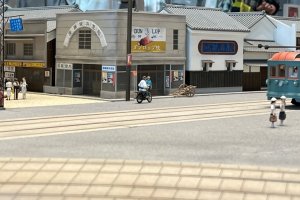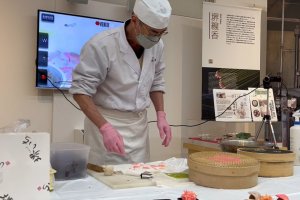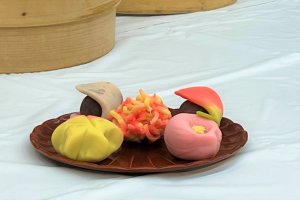Eat now! The owner barked. I looked at him sheepishly, my attention darting between the exquisite marzipan like floral creation and his eyes, torn as to whether to obey his command, or to look away, mesmerised by this miniature sculpture.
Before that abrupt moment, I was in my own world, thinking of where I can source a cup on hot green tea to cut through the rich, bean paste texture of this Japanese dessert called wagashi. Now I had nowhere to hide, sitting in plain sight on the front row, with only the counter separating me from the master’s voice.
My mind had drifted to the taste of the first harvest, when I was brought back to earth by his voice… “Not here” he softened, but “eat it today”, such was his passion for wagashi to be eaten at its best.
A Family History
Since 1909, the same family has been making and perfecting wagashi, with the grandfather Masao Takada being the first artisan to create a sweet potato wagashi in 1928, having discovered it at a Western confectionery store. The father then took over the business until he was unable to use his left hand from a stroke in 1970. The hand techniques are so important to wagashi making that scientists dissect the hand movements of these experienced chefs, and so his son took over at age of 18. His lifelong dedication bore fruit with an award and recognition from the Imperial family.
Wagashi and Sakai
Wagashi is as synomous to Sakai, as the first harvest of Gyokoro tea is to Uji or Shizouka. While these sweets were originally limited to the aristocracy, they became more popular when they were married with tea in the tea ceremony, where the sweetness of this dessert was thought to be a perfect complement to the astringent yet savory taste of tea.
Since then, wagashi has made its way into the milestones of life, from weddings to funerals, as well as the passing of the seasons. The motto of Minoya (literally meaning the house of beauty) is that we deliver the taste of good old Japan regardless of the waves ot time, and a neighbour remembers marking his graduation with some red and white manju, recalling a light sweetness that even his family, who don't like red bean paste, can enjoy.
Confectioneries in Sakai and nearby Kishiwada produce original sweets that change according to the season, as well as sweets that are available everyday.
The making of Wagashi and its ingredients
These days when I eat mass produced confectionery, the wrapping comes with a warning that it “may contain traces of tree nuts”. In a large industrial facility, you can accidentally have traces of nuts, but in the olden times, sweets were hand made in small batches, so the chance of accidental ingredients were much lower. At those times, they deliberartely sourced what was locally available, including nuts, grains, and beans. So there could be nuts in Wagashi, but it is there on purpose, not by accident. Peanuts are not usually used as an ingredient, but you are more likely to get soya or red beans.
The signature baked sweet potato is light, sourced from farms with a sandy soil, and covered in a light and flaky pastry with egg yolk and butter. It is best eaten within 7 days, so it is a good idea to buy some as souvenirs on the way to Kansai Airport. The store is open from 9am to 7pm Tue to Sat.
Vegan and Lactose Free Pleasures
It is amazing that most of these desserts are vegan, you wonder how they make it so delicious without milk, cream, or eggs. Actually, Japan was isolated for many years, and western diets such as sugar, eggs and milk was not introduced for many centuries (let alone chocolate, sourced from another kind of bean). So they were able to exalt such humble ingredients such as grains, nuts, beans and the sweet potato to great heights. They were unhindered by other ingredients, so they perfected what they had.
Location of the Store and Kitchen
Minoya is located in an non descript street, between an appliance store and the Hana okonomiyaki. Yet it is just a few meters away from Kishu Kaido, Japan’s oldest known highway. While overlooked by the shinkansen, this road carried merchants and pilgrims from times past, when Sakai was at the end of the Maritime Silk Road. At the Sakai Festival, you can see silk screens that testify to the wealth of these merchants. It is said that before Osaka, there was Sakai, and before Kyoto, there was Nara. We owe our pleasures to artisans like Minoya, that we can enjoy the same delights as the aristocrats of old.

































"The refinement of the process of wabi-cha came from one of the most unlikely of places. Far removed from the temples and gardens of Kyoto, it was actually the bustling, cosmopolitan and slightly crude port city of Sakai-shi in Osaka Prefecture that had the most profound influence on would be known as The Way of Tea."
Today you can visit the tea room that was used from those times, not far from this confectionery shop and kitchen.